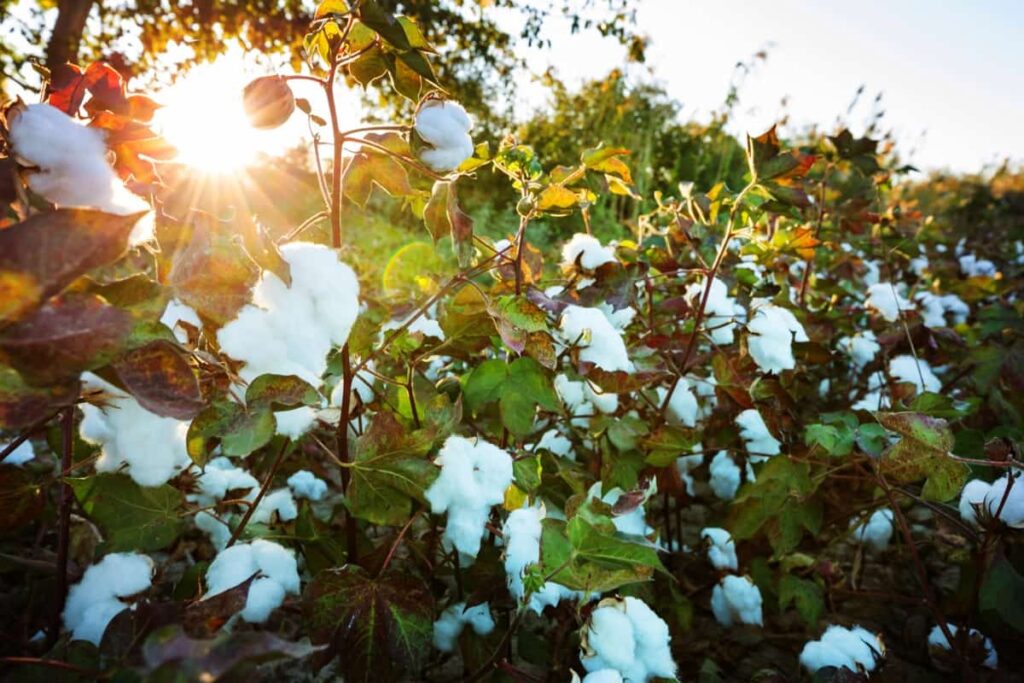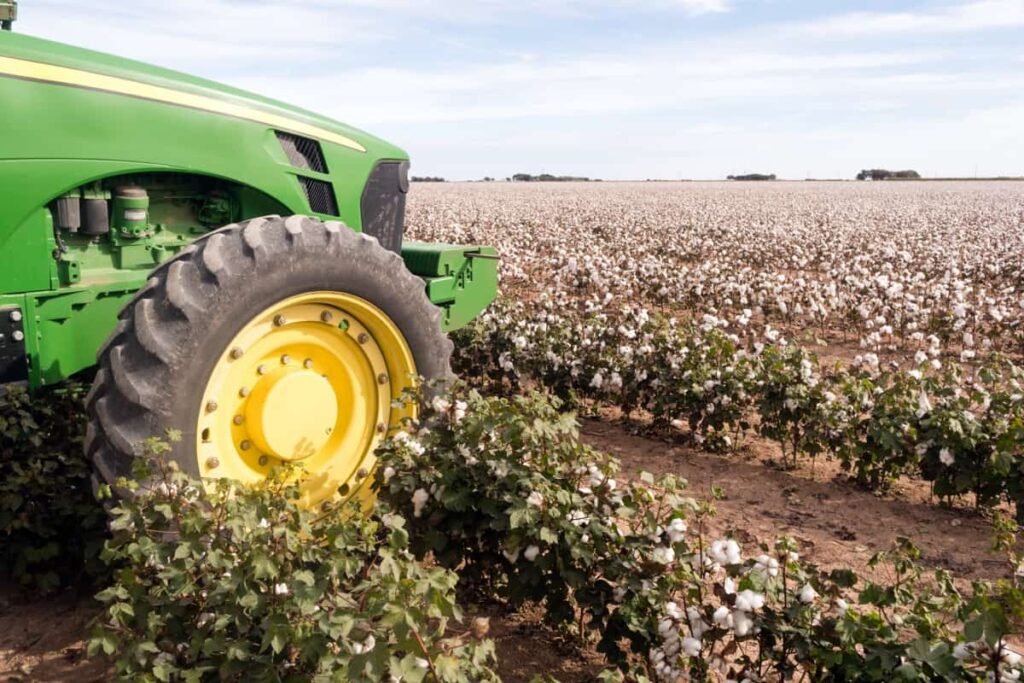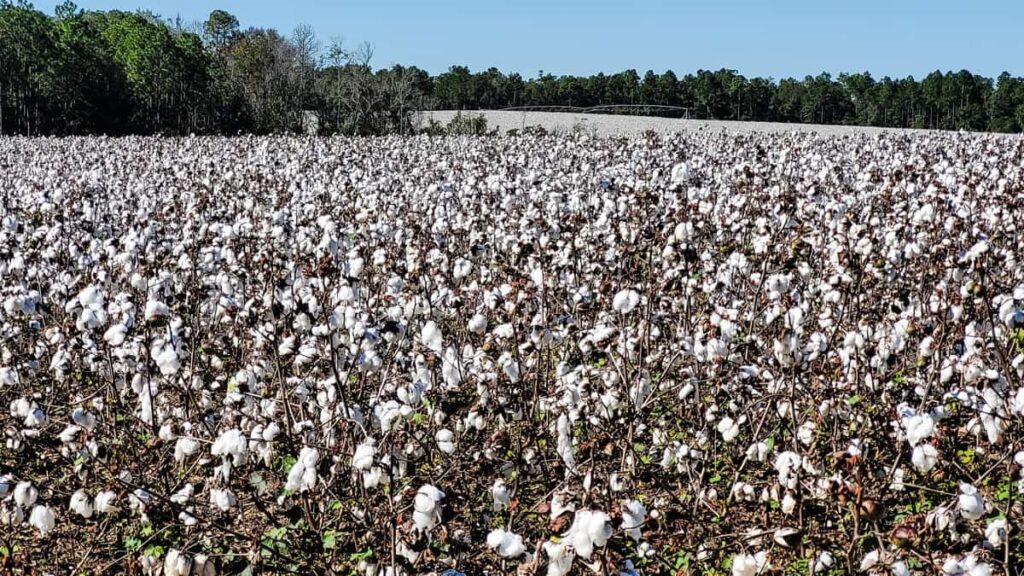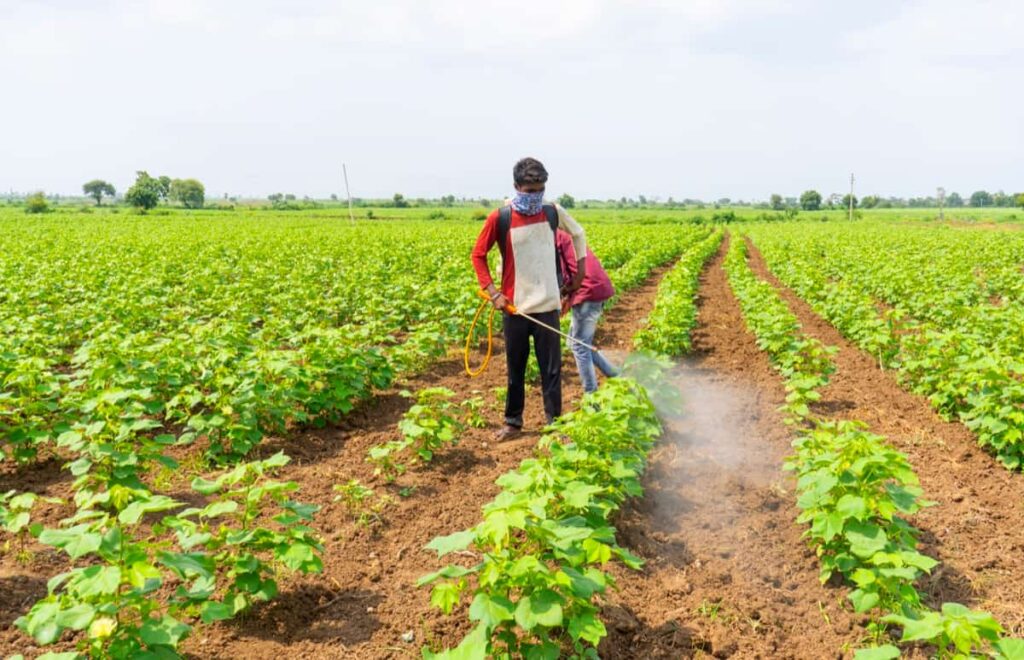In cotton farming, managing diseases is a crucial task requiring an integrated approach. This strategy targets the diseases and encompasses the entire farm ecosystem, including the host plants, potential pathogens, and environmental factors. Even if you don’t currently face significant disease issues, implementing basic disease management practices is wise, as it lowers the risk of future outbreaks.

Knowing which diseases might be lurking on your farm and where they are most likely to strike is vital. Conducting regular disease surveys throughout the growing season, both early and late, allows you to monitor and document your findings over time. Additionally, it’s essential to train your farm staff to recognize and report any unusual crop symptoms.
What is Disease Management in Cotton Farming?
Disease management in cotton farming is a critical aspect of this important agricultural sector, particularly in nations heavily reliant on agriculture. Cotton production faces constant threats from various pathogens that can lead to substantial economic losses. Globally, various diseases afflict cotton crops, including Fusarium and Verticillium wilt, Alternaria leaf spot, boll rot, seedling diseases, leaf curl disease, and bacterial blight. These diseases pose significant challenges to cotton fiber production.
Efforts in disease management primarily aim to keep disease incidence at a minimal level. Researchers focus on understanding the causes of these diseases (etiology) to assess their economic impact, aiding the development of effective management strategies. Cotton leaf curl has emerged as a major threat across cotton-growing regions due to shifts in viral disease complexes.
In addressing these challenges, we will gain insights into the history of major cotton diseases, host-pathogen interactions, the taxonomy of causal agents, and various control strategies. These strategies encompass traditional methods and innovative techniques like genome modification to enhance resistance.
Understanding Cotton Plant Diseases
- Disease Identification: Begin by discussing the various diseases that affect cotton plants, such as Fusarium and Verticillium wilt, Alternaria leaf spot, boll rot, seedling diseases, leaf curl disease, and bacterial blight. Provide information on the symptoms and signs associated with each disease.
- Pathogens and Taxonomy: Explore the causal agents behind these diseases, including their taxonomy and classification. Understanding the biology of pathogens is crucial for effective disease management.
- Economic Impact: Present data on the economic losses incurred due to cotton plant diseases. Highlight the significance of disease management in preserving cotton crop yields and the cotton industry’s economic stability.
- Host-Pathogen Interactions: Discuss the interactions between cotton plants and disease-causing pathogens. Explain how these interactions lead to infection and disease development.
- Disease Management Strategies: Describe traditional and modern disease management strategies. This should include cultural practices, chemical control, disease-resistant cotton varieties, and emerging techniques like genome modification for enhanced resistance.
In case you missed it: Pest Management in Cotton Farming: Natural, Biological, and Chemical Control

The Importance of Integrated Disease Management
Pathogen Control
- Prevention is Key: IDM starts with the fundamental principle that prevention is better than cure. It is far easier to prevent pathogens from entering your farm than to manage diseases once they take hold.
Come Clean Go Clean
- Managing Movements: Controlling the movement of machinery and vehicles within the farm is crucial. Implementing a strategy for ensuring clean movement minimizes the risk of disease spread one field to field, farm by farm, and region to region.
- Communication: Clear communication of hygiene requirements to all staff, contractors, and visitors is essential to maintain a disease-free environment.
- Minimize Spillage: Reducing spillage when transporting modules, hulls, cotton seeds, or gin trash further mitigates the risk of disease transmission.
Control Alternative Hosts and Volunteers
- Host-Free Period: Implementing a host-free period helps prevent the buildup of disease inoculum and reduces the carryover of diseases from one season to the next.
- Weed Management: Pathogens that affect cotton can also infect common weeds in cotton-growing areas. Controlling these alternative hosts, especially cotton volunteers and ratoons, is critical in reducing the risk of disease outbreaks.
Crop Residues
- Residue Management: Proper management of crop residues is essential to minimize the carryover of pathogens into subsequent crops. Residues should be incorporated into the soil after harvest, except in cases of Fusarium wilt, where slashing and surface retention are recommended.
Crop Rotations
- Diverse Cropping: Successive cotton crops can lead to a rapid increase in disease incidence. Crop rotation with non-host crops can help reduce disease pressure.
- Tools for Planning: Tools like the Cotton Rotation Finder and resources like the Australian Cotton Production Manual and Cotton Pest Management Guide aid in planning effective crop rotations.
Insect Vectors
- Vector Control: Controlling insect vectors that carry pathogens is crucial in disease prevention. For instance, controlling aphids can help prevent diseases like Cotton Bunchy Top (CBT) transmitted by these insects.
- Integrated Pest Management (IPM): Employing IPM practices is essential when managing pests that transmit diseases.
In case you missed it: High Yield Hybrid Cotton Varieties in India – For Rabi, and Kaharif Seasons

Managing the Host Crop
- Crop Health: A healthy cotton crop is more resistant to diseases. Strong seedling vigor and balanced crop nutrition, especially with nitrogen and potassium, make plants less susceptible to diseases.
- Nitrogen Management: Excess nitrogen can increase the risk of diseases such as boll rot, particularly in fully irrigated situations.
Resistant Varieties
- Choosing Resistant Varieties: Planting resistant cotton varieties is vital in reducing disease risk. Some varieties have good resistance to specific diseases like Verticillium wilt or Fusarium wilt.
- Seedling Vigor: Consider the seedling vigor of a variety, especially when watering up or planting early.
Managing Environmental Conditions
- Manipulating Conditions: Altering row or plant spacing, changing irrigation methods, frequency, or sowing dates can manipulate environmental conditions to make them less conducive to disease development and spread.
Planting
- Optimizing Stand Establishment: Planting into well-prepared, firm, and high beds optimizes stand establishment and seedling vigor. Careful positioning of fertilizers and herbicides prevents root damage.
- Soil Temperature: For healthy growth and disease prevention, ideal soil temperatures for cotton establishment should be maintained.
Irrigation Scheduling
- Pre-Planting Irrigation: Applying water before planting creates better conditions for seedling emergence. It helps prevent early-season water stress in plants with weakened root systems due to disease.
Agronomic Management
- Planting Rates: While high planting rates can compensate for seedling mortality, they can favor certain diseases. Optimized nitrogen, water management, and growth regulators help maintain a balanced canopy.
- Inter-Row Cultivations: In fields with Fusarium and Verticillium wilt, avoid inter-row cultivations after the seedling stage, as mechanical root damage can facilitate pathogen infection.
Common Cotton Crop Diseases
Seedling Diseases: Seedling diseases are a global concern, causing up to 5% yield loss annually. They are primarily caused by fungal pathogens such as Fusarium, Rhizoctonia, Pythium, and Thielaviopsis. Symptoms include damping off, decay, stunted growth, and seedling rot. Farmers should opt for disease-resistant cotton varieties to prevent seedling diseases, use high-quality seeds, and apply seed treatments with fungicides.
Alternaria Leaf Spot: Alternaria leaf spot is a foliar disease that affects cotton leaves, stems, bracts, and bolls. It manifests as circular brown lesions with purple margins, which can coalesce, resulting in blighted and brittle leaves. Management strategies include residue management, crop rotation, and foliar fungicides.
Grey Mildew Disease: Also known as false mildew or white mildew, this disease typically starts as irregular angular lesions on lower leaves and can lead to defoliation and boll opening. Control measures for grey mildew disease involve cultural practices like crop residue destruction, deep plowing, and selecting resistant cotton cultivars.
Boll Rot Disease: Boll rot disease is a significant concern in cotton-growing regions worldwide, especially in areas with high humidity during late summer and fall. It leads to better-quality lint production. Multiple microorganisms, with Fusarium spp. Being the most common, they are responsible for this disease. In the Americas, F. oxysporum, F. roseum, F. solani, and F. moniliforme are prevalent, while F. moniliforme, F. roseum, F. solani, and Colletotrichum spp. are involved in Africa. F. equiseti is reported in India.
In case you missed it: Best Fertilizer for Plum Trees: Organic, Natural, Homemade, NPK Ratio, and Schedule

Symptoms begin with water-soaked necrotic lesions on bract margins, which expand and develop fungal growth during moist conditions. Severe cases may lead to bolls dropping from the plants. Prevention involves agronomic practices like reducing nitrogen application, managing humidity, and burning diseased crop residues. Acid delinting and chemical control methods can also help.
Fusarium Wilt: Fusarium wilt is a vascular disease that affects cotton plants. It is caused by Fusarium oxysporum, which can lead to wilting symptoms, yellowing of lower leaves, and plant death. Control measures include planting resistant cotton varieties and implementing cultural practices.
Verticillium Wilt: Verticillium wilt is another vascular disease that can have a detrimental impact on cotton crops. It is caused by Verticillium dahliae and is characterized by symptoms like yellowing, epinasty, and defoliation of leaves. Control methods include using resistant cultivars and cultural practices.
Cotton Leaf Curl Disease (CLCuD): CLCuD is a viral disease transmitted by whiteflies. It leads to symptoms like leaf curling and stunted plant growth. CLCuD is associated with a complex of begomoviruses, betasatellites, and alphasatellites. Management strategies include planting resistant cotton varieties, implementing whitefly control measures, and ensuring proper field hygiene.
Disease Management for Healthy Cotton Crops
Regular Crop Monitoring: Begin by diligently monitoring your cotton crops for any signs of disease symptoms. Early detection is vital, allowing prompt action to mitigate disease spread. Keep records of where diseases are observed on the farm and track their impact over time. This data will help you make informed decisions about disease management.
Plant-Resistant Varieties: When dealing with known pathogens in your region, opt for cotton varieties that resist those specific diseases. Resistant varieties can significantly reduce the risk of disease outbreaks and limit their impact on crops. Consult local agricultural experts or extension services for guidance on suitable resistant varieties for your area.
Utilize Pathology Services: Consider utilizing industry pathology services if you encounter unusual symptoms or suspect a new disease. These services can help diagnose the issue accurately. Sending plant samples for diagnosis is a valuable step in promptly identifying and addressing emerging diseases.
Awareness and Reporting: It’s essential to create awareness among all farm personnel, contractors, and visitors about the diseases present on your farm. Encourage them to report any unusual disease symptoms they come across. Early reporting can be instrumental in preventing disease outbreaks from spreading uncontrollably.
In case you missed it: Best Outdoor Potted Plants for Atlanta: Winter, Low-maintenance, Shade, and Full Sun

Integrated Disease Management: Develop a comprehensive integrated disease management strategy for your farm. This strategy should encompass various tactics, including:
Optimal Planting Date and Temperature: Consider planting dates and conditions that minimize disease risk. Some diseases are more prevalent under specific environmental conditions, so adjusting your planting schedule accordingly can be a preventive measure.
Nutrition and Irrigation: Maintain a balanced approach to crop nutrition, particularly with nitrogen and potassium. Proper nutrient management can make plants less susceptible to diseases. Ensure irrigation practices are conducive to crop health, avoiding waterlogging that can promote certain diseases.
Control Volunteer and Ratoon Cotton: Manage volunteer and Ratoon Cotton diligently throughout the year. These can serve as reservoirs for pathogens, contributing to disease persistence. Implement practices to reduce their presence, such as timely removal and destruction.
Crop Residue Management: Proper management of crop residues is crucial to prevent the carryover of pathogens into subsequent crops. After harvest, incorporate crop residues into the soil as soon as possible. However, in diseases like Fusarium wilt, where residues can harbor pathogens, consider slashing and retaining residues on the surface for a specific period before incorporation.
Crop Rotations: Implement a well-planned crop rotation strategy that considers the diseases in your fields. Successive cotton crops can increase disease incidence. Rotate with non-host crops to break disease cycles. Use resources like the Cotton Rotation Finder to guide your rotation decisions.
Come Clean Go Clean Principles: Enforce strict biosecurity measures on your farm. Ensure that vehicles, equipment, and people adhere to the “Come Clean, Go Clean” principles. This involves rigorous hygiene practices to prevent the unintentional spread of diseases from field to field, farm to farm, and region to region.
In case you missed it: Crop Harvest Calendar for California: Fruits and Vegetables in Season by Month Chart of California

Conclusion
Effective disease management in cotton farming is essential for safeguarding crop health and ensuring sustainable yields. Implementing strategies like crop monitoring, resistant varieties, integrated management, and strict biosecurity measures is crucial to mitigate disease risks and optimize cotton production for a prosperous agricultural future.
- Management Pests and Diseases in Your Cotton Field
- Sheep Farming Business Plan for Beginners
- Aquaponic Farming at Home: A Step-By-Step Guide
- Profitable Village Farming Business Ideas in 2024
- High-Yield Aquaculture: Fast-Growing Fish for Farming
- Effective Fish Pond Construction Techniques for Beginners
- Irrigation and Water Management in Pineapple Farming
- Blossom to Harvest: Mastering Flowering and Pollination in Papaya Farming
- Pig Fattening Essentials: From Selection to Sale for Beginners
- Raising Wagyu Cattle: A Complete Guide for Premium Beef Production
- Soil Types and Their Water Holding Capacity
- Optimizing Irrigation Schedules for Coconut Groves for Enhanced Yield
- Espresso Your Garden: Coffee Grounds for Healthier Acid-Loving Plants
- The Best Soil Mix for Snake Plants: How to Mix Your Own Snake Plant Soil
- Green Thumb Success: Expert Tips for Cultivating Greenhouse Beans All Year Round
- Bloom All Year Round: The Ultimate Guide to Indoor Hyacinth Care
- Eco-Friendly Gardening: How to Make Liquid Fertilizer from Kitchen Waste
- Ultimate Guide to Grow Anise in Pots: Explore Seed Propagation to Harvesting
- Guide to Raising Chester White Pigs: Discover Breed Facts to Growth Management
- Mastering the Elegance: The Ultimate Guide to Weeping Cherry Tree Care, Planting, and Maintenance
- Ultimate Guide to Planting Garlic in Grow Bags: Growing Strategies for Beginners
- How to Fix Spider Plant Leaf-Related Problems: Natural and Organic Remedies
- 10 Reasons Why Your Tulsi Plant is Shedding Leaves: Home Remedies and Solutions
- Optimizing Growth and Yield: The Advantages of Palm Bunch Ash Fertilizer
- Utilizing Neem Oil Extract as a Natural Pesticide for Hydrangea
- From Soil to Harvest: Various Ways in Which Farmers Can Use AI Tools
- Steps to Encourage and Induce Citrus Flowers: A Comprehensive Guide
- How to Fix Snake Plant Leaf-Related Issues: Natural and Organic Remedies
- Transform Your Garden into a Fragrant Oasis with Raat Ki Rani (Night Blooming Jasmine)
- Discover the Ideal Chicken Breeds for Philippine Farms
- How to Create a Poultry Egg Farm Business Plan for Profits
- Grow Lemon Cucumbers Like a Pro: Insider Techniques for Bountiful Yields
- Ultimate Guide to Caring for Your Pink Princess Philodendron: Tips for Thriving Variegation
- Areca Nut Profit Per Acre: Calculating Yield and Cost of Cultivation
- How Kaveri Chicken is Becoming a More Profitable Breed in Indian Backyards
- Transform Your Barn: 9 Steps to Convert a Horse Stall into a Chicken Coop
